初中英语说课稿(英文版模板)(完整资料).doc
初中英语说课稿全英文版

初中英语说课稿全英文版work Information Technology Company.2020YEARGood morning, everyone. My name is Zhang Meiying. I come from Huishe Middle School. It’s my great honor to be here to present my lesson. My teaching topic is Sports Star Eats Well . I’ll talk about it by 6 parts:Part 1 the analysis of teaching material;Part 2 the analysis of teaching students;Part 3 the analysis of teaching methods;Part 4 the analysis of studying ways;Part 5 the analysis of teaching procedures;Part 6 blackboard design.Well, firstly, I’ll talk about Part 1, the analysis of teaching material.1. Status and function: The lesson is the fourth period of Unit 6. The main content of this lesson is likes and dislikes .It’s related to food.2. Teaching aims and demands, there are knowledge aims, ability aims and emotional aims. The knowledge aims are to enable the students to master the new words, star, eat, well, habit, healthy, really, question, want, be, fat. the phrases,eat well, eating habit, sports star, after dinner, one last question. the sentences,What do you like for breakfast/What fruit do you like The ability aims are to develop the students’ abilities of reading and writing, to train the students’abilities of using language, to guide the students to talk about likes and dislikes and to develop the students’ abilities of creative thinking and cooperative study. The emotional aims are to arouse the students’ interest in learning English, to enable the students to form good eating habits.3. Teaching key points and difficult points: The teaching key points are to enable students to use the new words, phrases and sentences in English, The difficult points are to enable students to talk about other’s eating habits..Then I’ll talk about Part 2 the analysis of students. The students have learned English for several years so far. But they are new in middle school. They are curious about new things and have a strong desire to learn better. However, their English learning level are different from each other. They need teacher’s help and encouragement in their further study.Let’s move on to another part: the analysis of teaching methods. In my lesson, I will use multimedia computer assisted instruction(多媒体计算机辅助教学), task-based activities(任务型教学法), situational approach(情境教学法).Next is the studying ways. Help the students to learn to study independently, learn to cooperate with others. In class, encourage the students to communicate with others and build up their confidence.Now I’ll talk about teaching procedures. I design my lesson into five steps. First, I’ll divide the students into 12 groups and bring a competition into the class.Step 1 is Greeting and Warm-up. Free talk between Teacher and Students. Such as:Today we’re going to talk about food.What kind of food do you like What do you like for breakfast What do your parents like for breakfast The food like milk break eggs or apple soup and so on may be appear in the student’s answers. By this, the students can be interested in it and pay their attention to our class easily Step 2 pre-reading. Here I’ll show the new words and phrases in this article .and also explain them in Engish. By this, the students can understand the article easily.Step 3 is reading. Firstly I will ask the students to read the article and circle the food words. Then read the words all together. Secondly ,I will let them read it again and write 5 sentences about Cindy’s eating habits. Like Cindy likes healthyfood./Cindy doesn’t like bananas. By this they will more familiar with the grammer of this unit .Thirdly ,they will be asked to translate 3 sentenses. What do you like for breakfastI love fruit. I think it’s healthy.Do you eat ice-cream after dinnerI don’t want to be fat. Fourthly ,answer questions.1Dose Cindy like chicken for breakfast2、Dose Cindy want to eat ice-cream3、What does Cindy like for breakfast4、What fruit does Cindy likeStep4 language points and exercises.Step 4 after readingNow the students need to write something to talk about others’ likes and dislikes about food . if time is enough ,some students should show their articles.Step 5 is Summarize and homework. Here I’ll ask the students such questions: What have we learned from this lesson What new phrases have we learned today At last, tell the students what today’s homework is.Ok, that’s all. Thanks for your listening. Goodbye.。
初中英语说课稿模板5篇
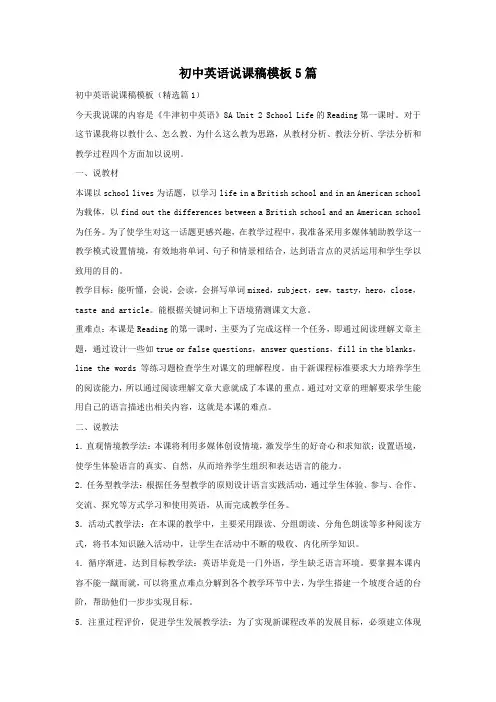
初中英语说课稿模板5篇初中英语说课稿模板(精选篇1)今天我说课的内容是《牛津初中英语》8A Unit 2 School Life的Reading第一课时。
对于这节课我将以教什么、怎么教、为什么这么教为思路,从教材分析、教法分析、学法分析和教学过程四个方面加以说明。
一、说教材本课以school lives为话题,以学习life in a British school and in an American school 为载体,以find out the differences between a British school and an American school 为任务。
为了使学生对这一话题更感兴趣,在教学过程中,我准备采用多媒体辅助教学这一教学模式设置情境,有效地将单词、句子和情景相结合,达到语言点的灵活运用和学生学以致用的目的。
教学目标:能听懂,会说,会读,会拼写单词mixed,subject,sew,tasty,hero,close,taste and article。
能根据关键词和上下语境猜测课文大意。
重难点:本课是Reading的第一课时,主要为了完成这样一个任务,即通过阅读理解文章主题,通过设计一些如true or false questions,answer questions,fill in the blanks,line the words等练习题检查学生对课文的理解程度。
由于新课程标准要求大力培养学生的阅读能力,所以通过阅读理解文章大意就成了本课的重点。
通过对文章的理解要求学生能用自己的语言描述出相关内容,这就是本课的难点。
二、说教法1.直观情境教学法:本课将利用多媒体创设情境,激发学生的好奇心和求知欲;设置语境,使学生体验语言的真实、自然,从而培养学生组织和表达语言的能力。
2.任务型教学法:根据任务型教学的原则设计语言实践活动,通过学生体验、参与、合作、交流、探究等方式学习和使用英语,从而完成教学任务。
初中英语全英说课稿优秀9篇
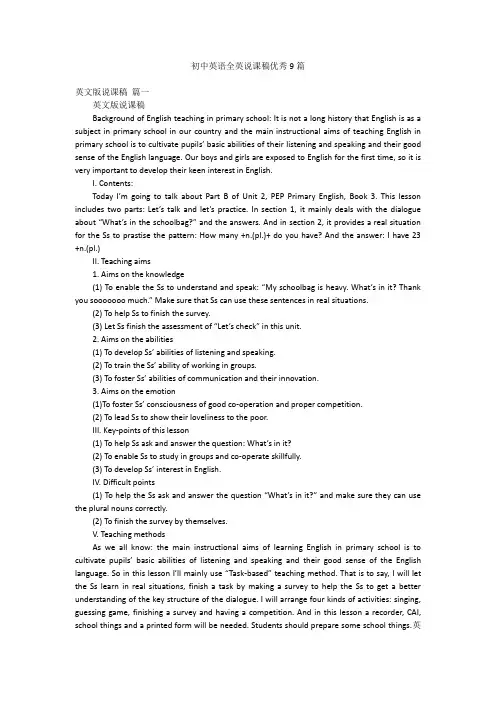
初中英语全英说课稿优秀9篇英文版说课稿篇一英文版说课稿Background of English teaching in primary school: It is not a long history that English is as a subject in primary school in our country and the main instructional aims of teaching English in primary school is to cultivate pupils’ basic abilities of their listening and speaking and their good sense of the English language. Our boys and girls are exposed to English for the first time, so it is very important to develop their keen interest in English.I. Contents:Today I’m going to talk about Part B of Unit 2, PEP Primary English, Book 3. This lesson includes two parts: Let’s talk and let’s practice. In section 1, it mainly deals with the dialogue about “What’s in the schoolbag?” and the answers. And in section 2, it provides a real situation for the Ss to prastise the pattern: How many +n.(pl.)+ do you have? And the answer: I have 23 +n.(pl.)II. Teaching aims1. Aims on the knowledge(1) To enable the Ss to understand and speak: “My schoolbag is heavy. What’s in it? Thank you sooooooo much.” Make sure that Ss can use these sentences in real situations.(2) To help Ss to finish the survey.(3) Let Ss finish the assessment of “Let’s check” in this unit.2. Aims on the abilities(1) To develop Ss’ abilities of listening and speaking.(2) To train the Ss’ ability of working in groups.(3) To foster Ss’ abilities of communication and their innovation.3. Aims on the emotion(1)To foster Ss’ consciousness of good co-operation and proper competition.(2) To lead Ss to show their loveliness to the poor.III. Key-points of this lesson(1) To help Ss ask and answer the question: What’s in it?(2) To enable Ss to study in groups and co-operate skillfully.(3) To develop Ss’ interest in English.IV. Difficult points(1) To help the Ss ask and answer the question “What’s in it?” and make sure they can use the plural nouns correctly.(2) To finish the survey by themselves.V. Teaching methodsAs we all know: the main instructional aims of learning English in primary school is to cultivate pupils’ basic abilities of listening and speaking and their good sense of the English language. So in this lesson I’ll mainly use “Task-based” teaching method. That is to say, I will let the Ss learn in real situations, finish a task by making a survey to help the Ss to get a better understanding of the key structure of the dialogue. I will arrange four kinds of activities: singing, guessing game, finishing a survey and having a competition. And in this lesson a recorder, CAI, school things and a printed form will be needed. Students should prepare some school things.英文版英语说课稿VI. Teaching procedures and purposes of my designing.I’ll finish this lesson in five steps.Step 1. Warm-up and preview1. Free talk between T and Ss about things in the classroom.2. Sing the song together: Books and pencils.3. Do some TPR, for example: Show me your English book. Show me your crayon.4. Review the numbers by asking: “How many crayons do you have?”Purpose: It is important to form a better English learning surrounding for the Ss by singing and doing some total physical response and at the same time it provides situations to review learned knowledge for the next step.Step 2. PresentationNow I’ll mainly talk about this step.1. Present the pattern: “My schoolbag is heavy.” “What’s in it?.”(1) Show a bag and say: “Look! I have a bag.” Carry it and say: “Oh, it is heavy. My schoolbag is heavy.” Help the Ss understand the meaning with the help of my body language. Then lead the Ss to read the sentence. Make sure they can say it correctly.(2) T: My schoolbag is heavy.Open the bag and say: “What’s in it? What’s in my schoolbag?”Take out a Chinese book. Then do the action again. Let the Ss read the sentence.2. Play a guessing game. Divide the whole class into four groups to have a competition.Let them guess: What’s in the bag? How many? Purpose: To present the key structures one by one is much easier for the Ss to learn and grasp the meanings. Proper competition can arouse the Ss’ interest in English learning.3. With the help of the CAI to present the dialogue. Set a situation to help Ss understand: Two Ss are coming. One girl is carrying a heavy bag on her back. They are talking.Girl: My schoolbag is heavy.Boy: What’s in it?Girl: 20 story-books, 32 pencil, 9 rulers, 12 crayons and 30 picture-books. Etc.Boy: What will you do?Girl: They are for the poor.Boy: Great! I’ll bring some school things too.The boy comes back home and puts a lot of things into the bag. Then he goes to school again and gives them to a teacher. While he is taking them out, he is counting the numbers of all things. The teacher says: Thank you soooooooo much.4. Mention that we should take care of the poor.5. Play the cassette. Let the Ss listen and imitate the dialogue.Pay attention to their pronunciation and intonation. Purpose: CAI can provide a real situation for the Ss to understand the dialogue and the relationships between people better. Tell the Ss we should show our loveliness to the Ss.Step 3. PracticeDivide Ss into groups of six children. Each one would finish the printed form by asking and answering: How many storybooks do you have? Find out which group finishes faster. Story books picture-books sharpeners crayons pencils erasers pencil-cases rulers Chen Jie 8 24 3 32 26 4 1 3Purpose: Task-based teaching method is used here to develop Ss’ ability of communication and also their ability of co-operation will be well trained.Step 4. AssessmentHelp Ss finish “Let’s check” of this unit and workbook.Purpose: To check the knowledge Ss have learned in this period.Step 5. Add-activity1. Let Ss tell each other how many school things they have after class. Tell their parents how many school things they have at home.2. Take care of everything they have.Purpose: Revision is so important that Ss should speak English as much as they as in class or after class. It is necessary for the Ss to do some extensive exercises after class to consolidate the knowledge they learned.英文版英语说课稿初中英语说课稿篇二今天我的说课内容是新目标英语八年级上册第四单元第一课时。
初中英语全英说课稿(优秀5篇)
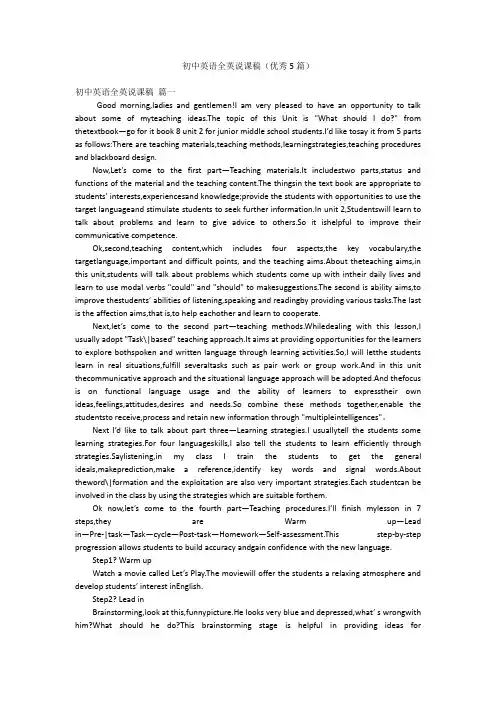
初中英语全英说课稿(优秀5篇)初中英语全英说课稿篇一Good morning,ladies and gentlemen!I am very pleased to have an opportunity to talk about some of myteaching ideas.The topic of this Unit is "What should I do?" from thetextbook—go for it book 8 unit 2 for junior middle school students.I’d like tosay it from 5 parts as follows:There are teaching materials,teaching methods,learningstrategies,teaching procedures and blackboard design.Now,Let’s come to the first part—Teaching materials.It includestwo parts,status and functions of the material and the teaching content.The thingsin the text book are appropriate to students’ interests,experiencesand knowledge;provide the students with opportunities to use the target languageand stimulate students to seek further information.In unit 2,Studentswill learn to talk about problems and learn to give advice to others.So it ishelpful to improve their communicative competence.Ok,second,teaching content,which includes four aspects,the key vocabulary,the targetlanguage,important and difficult points, and the teaching aims.About theteaching aims,in this unit,students will talk about problems which students come up with intheir daily lives and learn to use modal verbs "could" and "should" to makesuggestions.The second is ability aims,to improve thestudents’ abilities of listening,speaking and readingby providing various tasks.The last is the affection aims,that is,to help eachother and learn to cooperate.Next,let’s come to the second part—teaching methods.Whiledealing with this lesson,I usually adopt "Task\|based" teaching approach.It aims at providing opportunities for the learners to explore bothspoken and written language through learning activities.So,I will letthe students learn in real situations,fulfill severaltasks such as pair work or group work.And in this unit thecommunicative approach and the situational language approach will be adopted.And thefocus is on functional language usage and the ability of learners to expresstheir own ideas,feelings,attitudes,desires and needs.So combine these methods together,enable the studentsto receive,process and retain new information through "multipleintelligences"。
(完整版)初中英语说课稿(英文版).doc
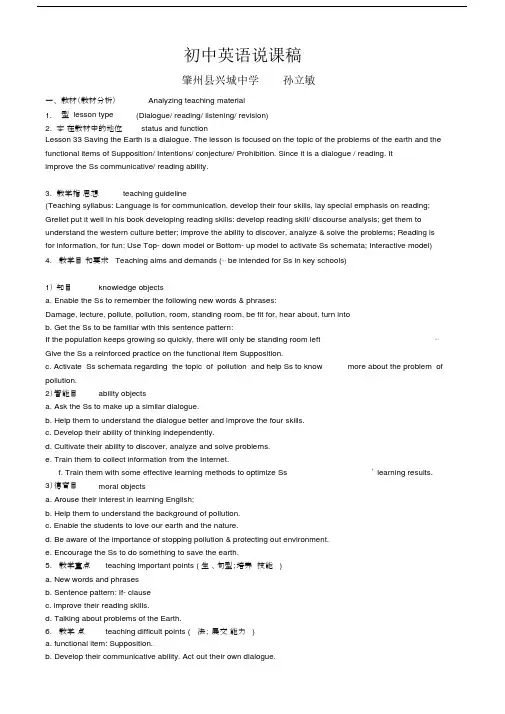
初中英语说课稿肇州县兴城中学孙立敏一、教材(教材分析)Analyzing teaching material1. 型 lesson type (Dialogue/ reading/ listening/ revision)2. 本在教材中的地位status and functionLesson 33 Saving the Earth is a dialogue. The lesson is focused on the topic of the problems of the earth and the functional items of Supposition/ Intentions/ conjecture/ Prohibition. Since it is a dialogue / reading. Itimprove the Ss communicative/ reading ability.3. 教学指思想teaching guideline(Teaching syllabus: Language is for communication, develop their four skills, lay special emphasis on reading; Grellet put it well in his book developing reading skills: develop reading skill/ discourse analysis; get them to understand the western culture better; improve the ability to discover, analyze & solve the problems; Reading is for information, for fun; Use Top- down model or Bottom- up model to activate Ss schemata; Interactive model) 4. 教学目和要求 Teaching aims and demands (⋯ be intended for Ss in key schools)1)知目knowledge objectsa. Enable the Ss to remember the following new words & phrases:Damage, lecture, pollute, pollution, room, standing room, be fit for, hear about, turn intob. Get the Ss to be familiar with this sentence pattern:If the population keeps growing so quickly, there will only be standing room left ⋯Give the Ss a reinforced practice on the functional item Supposition.c. Activate Ss schemata regarding the topic of pollution and help Ss to know more about the problem of pollution.2)智能目ability objectsa. Ask the Ss to make up a similar dialogue.b. Help them to understand the dialogue better and improve the four skills.c. Develop their ability of thinking independently.d. Cultivate their ability to discover, analyze and solve problems.e. Train them to collect information from the Internet.f. Train them with some effective learning methods to optimize Ss ’ learning results. 3)德育目moral objectsa. Arouse their interest in learning English;b. Help them to understand the background of pollution.c. Enable the students to love our earth and the nature.d. Be aware of the importance of stopping pollution & protecting out environment.e. Encourage the Ss to do something to save the earth.5. 教学重点teaching important points ( 生、句型;培养技能 )a. New words and phrasesb. Sentence pattern: If- clausec. improve their reading skills.d. Talking about problems of the Earth.6. 教学点teaching difficult points ( 法;展交能力 )a. functional item: Supposition.b. Develop their communicative ability. Act out their own dialogue.7. 说教具teaching aids (multi-media computer, software, OHP)The teaching syllabus says that it ’ s necessary for teachers to use modern teaching facilities. It increase the class density and improve our teaching result. It can also make the Ss reach a better understanding of the text by making the classes lively and interesting. At the same time, it arouses the Ss’interest in learning English.二、说教法Teaching methodsFive step method; audio-video; communicative approach;Task-based learning: New Syllabus Design encourages teachers to use this teaching method. TBLT can stimulate Ss’ initiative in learning and develop their ability in language application. Make the Ss the real masters in class while the teacher himself acts as the director and bring their ability into full play.三、说学法Study methods1.Teach Ss how to be successful language learners.2.Teach Ss how to develop the reading skill — skim & scan; how to communicate with others; how to learn new words; how to learn independently;3.Get the Ss to form good learning habits.四、说教学过程Teaching proceduresI.复习 (Revision) 5min (Daily report; 词汇 diagram; brainstorming; activate schemata)Activity 1: Imagination1). Suppose a bottle of ink is turned over and dirties your white shirt, what is to be done? (Wash it? Or throwit away?)2). Suppose you catch a bad cold, what’ s to be done?3). Suppose your bike is broken, what’ s to be done?4). And suppose the earth, on which we all live, is damaged, what’ s to be done?*What can you think of when you see “ pollution this”word?(waste, environment, air, water, factory, desert, climate... Try to activate the Ss schemata regarding the topic of pollution.)II.呈现 (Presentation) 5minActivity 2: PresentationPlay the song“ Earth Song” sung by Michael Jackson. (Create an atmosphere)A lot of pictures and video clips about the causes and results of the three problems mentioned in this lesson will be shown on the screen with the help of the computer.Ss’presentation on pollution. Attract their attention, arouse their interest, and create a good atmosphere for communication.*Activate their schemata and cultivate their ability in collecting information from the Internet and developtheir ability in thinking independently.1.Pre- readingActivity 3: Prediction1st listening/ fast reading, one guided Q to help Ss to get the main idea:What do you think is discussed at the conference?2.While- readingActivity 4: Read and answer2nd listening/ careful reading, more Qs to get the detailed information. Develop their reading skills: skim & scan. Pay attention to the pronunciation, stress & intonation.* 阅读 : Pre-reading; while-reading; post-reading (fast reading/ careful reading; skim/ scan; 识别关键词 key words;确定主题句;创设信息差 information gap ;T or F; 填表格 chart/diagram; Predicting; Make a timeline; Make a story map 。
初中英语说课稿模板(Word版,全英文)
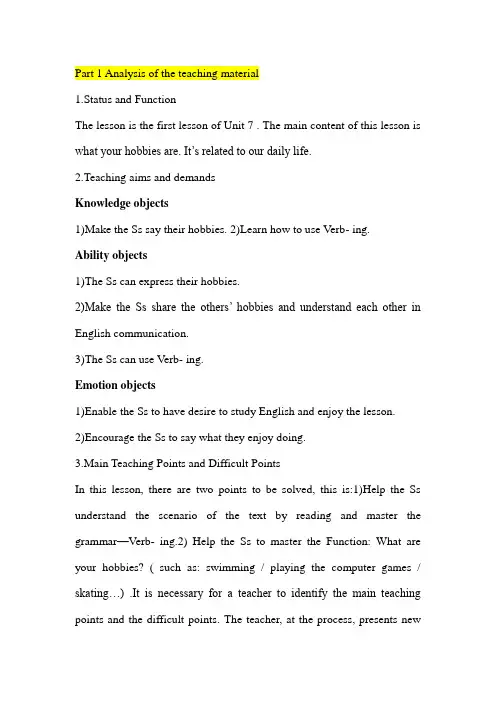
Part 1 Analysis of the teaching material1.Status and FunctionThe lesson is the first lesson of Unit 7 . The main content of this lesson is what your hobbies are. It’s related to our daily life.2.Teaching aims and demandsKnowledge objects1)Make the Ss say their hobbies. 2)Learn how to use Verb- ing.Ability objects1)The Ss can express their hobbies.2)Make the Ss share the others’ hobbies and understand each other in English communication.3)The Ss can use Verb- ing.Emotion objects1)Enable the Ss to have desire to study English and enjoy the lesson.2)Encourage the Ss to say what they enjoy doing.3.Main Teaching Points and Difficult PointsIn this lesson, there are two points to be solved, this is:1)Help the Ss understand the scenario of the text by reading and master the grammar—Verb- ing.2) Help the Ss to master the Function: What are your hobbies? ( such as: swimming / playing the computer games / skating…) .It is necessary for a teacher to identify the main teaching points and the difficult points. The teacher, at the process, presents newlanguage items and explains model skills, lets the Ss have more opportunities to express the new language and use in each activity.4.Teaching aidsblackboard , pictures , tape recorder , multi-media computerPart 2 Analysis of the studentsMost of the students in this class aren’t good at English because their English teacher is often changed. They don’t often use English to express themselves and communicate with others. Some students aren’t active in the clas s, they don’t want to open their mouths because they are afraid of making mistakes.Part 3 Teaching methodsAccording to New Course Standard of English, combining with the language level of Ss, I take Three task-teachings; Communicative methods; Aural-oral methods with the help of the computer.In the teaching process, I will apply blackboard , pictures , tape recorder and multi-media computer to arouse the Ss’ interests in learning.Part 4 Learning StrategiesIn the process of learning , lots of linguistic activities are to be applied. Because the language activity-practice is the only approach for Ss to master either the basic knowledge of English or the language competence.Help the Ss to learn to study independently, learn to cooperate with others.In class, encourage the Ss to communicate with others and build up their confidence.Part 5 Teaching proceduresStep 1 Pre-task1.Listen to the song “You Are You!”(Song is a good way to relax the Ss themselves. By listening to the song , the Ss can receive so me moral education. It’s helpful to teach the lesson.)2.Warming up . (In this period, I’ll show some pictures of hobbies to arouse the Ss’interests.)3.Free talk. Show some pictures and ask. (individual work)a.Do you like writing/reading/……?T: He likes writing. Writing is his hobby.b.Do you have a hobby?c.Would you like to have a hobby?d.What’s your hobby?(It provides a chance for the Ss to improve and practice their speaking skills.)Step 2 While-task1. Introduce the new words on the screen. (class work)hobby guess sell frame wall instruction roll2.Introduce the meaning of “hobby”. (A hobby is just something you like to do in your spare time. It’s fun!)3.Play the tape, while making the Ss answer the questions:a.Where is Danny now?b.What would he like to buy?c.Did he buy a tree? Why?d.What did he buy at last?Step 3 Post-task1.Add –ing after the verbs and discuss the regulars of verb-ing. (group work)skate-skating ; run-running ; read-reading ;listen-listening ; sing-singing动词-ing形式的构成:⑴、一般在动词原形末尾加-ing。
初中英语全英文说课稿模板
初中英语全英文说课稿模板make XXX.Third。
the nal objective:XXX reading and learning English。
and to XXX China and other countries.Part 2 The analysis of studentsThe target students of this lesson are Grade 8 students who have already learned basic English knowledge and skills。
They have a certain level of English n。
but still need to XXX。
Some students may be more interested in the topic。
while others may need XXX.Part 3 Teaching methodsIn this lesson。
I will use a n of us teaching methods。
such as task-based learning。
XXX。
and XXX ns。
debates。
and XXX their confidence in using English.Part 4 Teaching resI will start XXX related to the topic to arouse students' interest and XXX knowledge。
Then。
I will give a brief n to the article and explain some new words and phrases。
After that。
Iwill guide students to read the article and help them to understand the main idea and specific n。
初中英语全英文说课稿模板.doc
(全英)经典初中英语说课稿Good afternoon, my dear judges, I am ______, from ______, it is my great honor to have this opportunity to talk about my teaching ideas. My presentation consists of six parts. the analysis of teaching material,the analysis of students, teaching methods, teaching procedures and blackboard design.Part 1 The analysis of the teaching materialThis lesson is a reading passage, which focused on the topic of __________________, such a topic is related to our daily life, so it is easy to arouse theSs’ learning interests.My teaching objectives include the following parts.First, the knowledge objective :By the end of this lesson, Ss can learn the new words and new phrases: 其他参考活动:Debate---- 当话题有矛盾的双面D iscussion——当话题是讨论解决问题D o a survey——调查Understand the main idea of the article;And master the usage of ___________________某(个语法点 ) Second, the Ability objective:skim for the main idea of the article andscan for the specific information,predict some information andunderstand the whole article, andenlarge the relative knowledge by reading more materials in library orfrom internet, write a report of the topic, etc. Third , the emotionalobjective:to develop the spirit of cooperation through t eamwork and pair-discussion;arouse Ss’ interest in English learningFourth, the Cultural awarenessFifth ,the Important points:to get an overall understanding of the whole text,and develop their reading skills such as anticipating, skimming, scanning, summarizing language points ..(具体课型用具体例子阐述)the usage of the______________________(语法或句型 )While the Difficult points:Are enable the Ss to use the new words and phrases to express theirideas in daily life, and develop the ability of skimming and scanning.master the usage of ____________________________语(法或句型 )根据教学过程设计的内容来决定)Part 2The analysis of studentsThe Ss have learned English for some years. They understand some words and simple sentences. They are curious, active, and fond of game, competition, and various activities. They enjoy learning through cooperation in a relaxing atmosphere. Part 3 Teaching methodsIn this lesson, My teaching methods include audio-visual teaching method, communicative teaching method, and task-based teaching methods.Besides, a computer, blackboard, a tape recorder, a projector are needed as the teaching aids.Part 4Teaching proceduresThere are five steps in my teaching procedures. But before teaching, I will divide the whole class into 4 groups to do competitions while finish different tasks in this lesson.Step 1 Warming-up and leading in (3mins)Free talk; talk something related the topic of the article.参考活动:Brainstorming, setting the scene, show pictures etc.Purpose: activate the Ss to regard the topic of ___________________主(题) and create a relaxing atmosphere.Step 2 Pre-reading (10mins)There are 3 tasks for the Ss.(1)Do a guessing game.(2)Show some funny pictures and sentences on PPT and then ask the Ssto(3)Guess the meaning of the new words.Practice the new words and phrases:Match the new words and phrases with the Chinese meanings.Predicting: based on the title/ pictures on the text. (看具体情况而定 )Purpose: through guessing, to arouse Ss learning interest, and help themto learn the new words and phrases which they may come across whilereading, pave the way for the following learning and cultivate the ability of anticipating.{Meanwhile, pronunciation of some letter strings such as“ ea” (pe feast..) and “ er (cucumber” ⋯ )are highlighted so as to foster students’phonetic sensitivity.} (如果有音教学可渗透。
完整版)初中英语说课稿(英文版)
完整版)初中英语说课稿(英文版)XXX。
students will XXX XXX.2)技能目标skill objectsXXX' ability to discover。
analyze。
and solve problems。
as well as improve their four language skills。
with a special emphasis on reading。
Students will learn to use Top-down model or Bottom-up model to XXX.3)情感态度目标affective objectsXXX' awareness of environmental issues and XXX them to take n to XXX.二、说教法Teaching methods1.任务型教学task-based teachingThe lesson will be taught using a task-based approach。
where students will be given a task to XXX/reading。
This will help them to apply the language XXX real-XXX.2.交互式教学XXXInteractive teaching methods will be used to XXX group ns。
role-plays。
and XXX.3.多媒体辅助教学multimedia-assisted teachingMultimedia tools such as videos。
pictures。
and online resources will be used to enhance students' understanding of the topic and engage their interest。
完整版)初中英语说课稿全英文版
完整版)初中英语说课稿全英文版Good morning。
everyone。
My name is Zhang Meiying and I am from Huishe Middle School。
I am honored to be here today to present my lesson on the topic of "Sports Star Eats Well"。
My n will be divided into six parts:Part 1: Analysis of the teaching materialPart 2: Analysis of the studentsPart 3: Analysis of the teaching methodsPart 4: Analysis of the study methodsPart 5: Analysis of the teaching resPart 6: Blackboard design.Now。
let's start with Part 1.the analysis of the teaching material.The lesson I will be discussing is the fourth d of Unit 6.which focuses on likes and dislikes related to food。
The main objectiveof this lesson is to teach students about the importance of healthy eating habits for sports stars。
To achieve this objective。
we will analyze the following aspects:1.Status and n: The lesson is an integral part of the curriculum and plays a significant role in helping students understand the importance of healthy eating habits for athletes.Let's move on to Part 2.the analysis of the students.Teaching aims and demands include knowledge aims。
- 1、下载文档前请自行甄别文档内容的完整性,平台不提供额外的编辑、内容补充、找答案等附加服务。
- 2、"仅部分预览"的文档,不可在线预览部分如存在完整性等问题,可反馈申请退款(可完整预览的文档不适用该条件!)。
- 3、如文档侵犯您的权益,请联系客服反馈,我们会尽快为您处理(人工客服工作时间:9:00-18:30)。
此文档下载后即可编辑初中英语说课稿模板(英文版)Good morning, my dear judges, I am______. It is my pleasure to have this opportunity to talk about my teaching ideas. Now I will say section A (1a to 1c)of unit_____.It is from Grade_____in Go for it.The title is____________________.My presentation consists of——————parts.Part 1 The analysis of the teaching materialIt includes the following parts.First,status and functionThis lesson is a reading passage, which focused on the topic of __________________, such a topic is related to our daily life, so it is easy to arouse the Ss’ learning interests.Second,teaching aims and demandsthe knowledge objective :By the end of this lesson, Ss can learn the new words and new phrases:______________________________________ Understand the main idea of the article;And master the usage of ___________________(某个语法点)the Ability objective:skim for the main idea of the article andscan for the specific information,predict some information andunderstand the whole article, andenlarge the relative knowledge by reading more materials in library or from internet, write a report of the topic, etc.the emotional objective:to develop the spirit of cooperation through teamwork and pair-discussion;arouse Ss’ interest in English lear ningThird, the Important points:to get an overall understanding of the whole text,and develop their reading skills such as anticipating, skimming, scanning, summarizing language points…..…(具体课型用具体例子阐述)the usage of the______________________( 语法或句型)Fouth the Difficult points:Are enable the Ss to use the new words and phrases to express their ideas in daily life, and develop the ability of skimming and scanning.master the usage of ____________________________( 语法或句型)根据教学过程设计的内容来决定)Part 2 The analysis of studentsThe Ss have learned English for some years. They understand some words and simple sentences. They are curious, active, and fond of game, competition, and various activities. They enjoy learning through cooperation in a relaxing atmosphere.Part 3 Teaching methodsIn this lesson, My teaching methods includecommunicative teaching method, and task-based teaching methods. Besides, a computer, blackboard, a tape recorder, OHP and powerpoint are needed as the teaching aids.Part 4 Teaching proceduresThere are five steps in my teaching procedures.Step1Warming-up and leading in (3mins)Free talk; talk something related the topic of the article.show pictures .Purpose: activate the Ss to regard the topic of ___________________(主题) and create a relaxing atmosphere.Step2Pre-reading (10mins)There are 2tasks for the Ss.First,Do a guessing game.Show some funny pictures and sentences on PPT and then ask the Ss toGuess the meaning of the new words. Then ,ask some students to answer their key.right or wrong,d on’t tell them,now.let them f ind by themselves when studying the test.Second ,Practice the new words and phrases:Match the new words and phrases with the Chinese meanings. The left is English words and phrases,the right is Chinese meanings,ask some students to answer. Purpose: through guessing, to arouse Ss learning interest, and help them to learn the new words and phrases which they may come across while reading, pave the way for the following learning .Step3While- reading (15mins)Listen to the tape There are two tasks for the Ss.first reading:Ss read the article as quickly as they can and try to get the general idea by answer the following questions.Q1: who/ when/ what/ ……….second reading: pair-discussionSs read the article more carefully, and then discuss with their partners to finish the exercises .T he two tasks are aim to develop Ss’ reading ability. And then get a deep understanding of the article.Step 4 Post-reading (10mins)1)Group discussion: fill in the blanksSs discuss the article with their group members, and find out the language points, such as the key words, phrases, and sentence structures in the article.And then fill in the blanks in a short passage present on the PPT. The short passage is made up from the article, and the answers are the language points in thislesson.After check the answers, I will help the Ss to summarize the language points. 2)Retell:(As the students retell the key words。
Prompt the student to pay attention to correct use of the tenses)Use the key word and phrases presented on the PPT to retell the article. Purpose: Through group work, cultivate the spirit of cooperation, and train the ability of solve problem by themselves. In class, the teacher is just a guide, while the Ss are the center, where, the teacher just join them, giving suggestions, and offering help when they need. Meanwhile, ask the Ss to retell the article, is an output, and it can evaluates how well the Ss learned in this lesson.Step 6Homework (2mins)G o over today’ lesson and preview the next lesson.Then write 5 sentences with this lesson learned new words and phrases.Purpose: consolidate the language points and do prepare for the next lesson, and develop the ability of writing.Part 5 blackboard writing designTitleN ew words new phrases grammar focusPart6 teaching evaluationGenerally, when I finish class ,the part time still remains 5minutes,it will be to leave the students exchange discussion. I will use this part time to help some students who has certain difficulty on the English students. Anyhow I will try my best to make the class alive and encourage the students to speak more and keep smiling and praising them.I think that I will arouse their interest in studying English. That’s all about my teaching ideas of this lesson.Thanks you !首先first, to mention first, to begin with, first of all, firstly接着secongly,then,besides,what's more,in addition,thirdly,...as follow最后at last,last but not the least,above all,all in all, to sum up,in one word, on the whole,finally。
